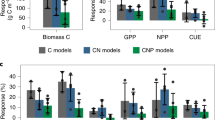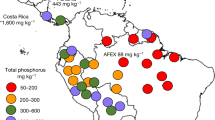Abstract
Northern mid-latitude forests are a large terrestrial carbon sink1,2,3,4. Ignoring nutrient limitations, large increases in carbon sequestration from carbon dioxide (CO2) fertilization are expected in these forests5. Yet, forests are usually relegated to sites of moderate to poor fertility, where tree growth is often limited by nutrient supply, in particular nitrogen6,7. Here we present evidence that estimates of increases in carbon sequestration of forests, which is expected to partially compensate for increasing CO2 in the atmosphere, are unduly optimistic8. In two forest experiments on maturing pines exposed to elevated atmospheric CO2, the CO2-induced biomass carbon increment without added nutrients was undetectable at a nutritionally poor site, and the stimulation at a nutritionally moderate site was transient, stabilizing at a marginal gain after three years. However, a large synergistic gain from higher CO2 and nutrients was detected with nutrients added. This gain was even larger at the poor site (threefold higher than the expected additive effect) than at the moderate site (twofold higher). Thus, fertility can restrain the response of wood carbon sequestration to increased atmospheric CO2. Assessment of future carbon sequestration should consider the limitations imposed by soil fertility, as well as interactions with nitrogen deposition.
This is a preview of subscription content, access via your institution
Access options
Subscribe to this journal
Receive 51 print issues and online access
$199.00 per year
only $3.90 per issue
Buy this article
- Purchase on Springer Link
- Instant access to full article PDF
Prices may be subject to local taxes which are calculated during checkout



Similar content being viewed by others
References
Tans, P. P. & White, J. W. C. In balance, with a little help from the plants. Science 281, 183–184 (1998).
Ciais, P., Tans, P. P., Trolier, M., White, J. W. C. & Francey, R. J. A large Northern Hemisphere terrestrial CO2 sink indicated by 13C/12C of atmospheric CO2. Science 269, 1098–1102 (1995).
Schimel, D. S. Terrestrial ecosystems and the carbon cycle. Global Change Biol. 1, 77–91 (1995).
Houghton, R. A., Davidson, E. A. & Woodwell, G. M. Missing sinks, feedbacks, and understanding the role of terrestrial ecosystems in the global carbon balance. Global Biogeochem. Cycles 12, 25–34 (1998).
Idso, S. B. & Kimball, B. A. Tree growth in carbon-dioxide enriched air and its implications for global carbon cycling and maximum levels of atmospheric CO2. Global Biogeochem. Cycles 7, 537–555 (1993).
Vitousek, P. M. & Howarth, R. W. Nitrogen limitations on land and in the sea: How can it occur? Biogeochemistry 13, 87–115 (1991).
Linder, S. Foliar analysis for detecting and correcting nutrient imbalances in Norway spruce. Ecol. Bull. 44, 178–190 (1995).
Körner, C. Towards a better experimental basis for upscaling plant responses to elevated CO2 and climate warming. Plant Cell Env. 19, 1101–1110 (1995).
Aber, J. et al. Nitrogen saturation in temperate forest ecosystems. Bioscience 48, 921–934 (1998).
Nadelhoffer, K. J. et al. Nitrogen deposition makes a minor contribution to cabon sequestration in temperate forests. Nature 398, 145–148 (1999).
Wullschleger, S. D., Post, W. M. & King, A. W. in Biotic Feedbacks in the Global Climatic System (eds Woodwell, G. M. & Mackenzie F. T.) 85–107 (Oxford Univ. Press, New York, 1995).
Hu, S., Chapin III, F. S., Firestone, M. K., Field, C. B. & Chiarello, N. R. Nitrogen limitation of microbial decomposition in a grassland under elevated CO2. Nature 409, 188–191 (2001).
Norby, R. J. & Cotrufo, M. F. A question of litter quality. Nature 396, 17–18 (1998).
Berntson, G. M. & Bazzaz, F. A. Belowground positive and negative feedbacks on CO2 growth enhancement. Plant Soil 187, 119–131 (1996).
DeLucia, E. H. et al. Net primary production of a forest ecosystem with experimental CO2 enrichment. Science 284, 1177–1179 (1999).
Ellsworth, D., Oren, R., Ce, H., Phillips, N. & Hendrey, G. Leaf and canopy responses to elevated CO2 in a pine forest using a free-air CO2 enrichment technique. Oecologia 104, 139–146 (1995).
Oren, R., Ewers, B. E., Todd, P., Phillips, N. & Katul, G. Water balance delineates the layer in which soil moisture affects canopy conductance. Ecol. Appl. 8, 990–1002 (1998).
Comins, H. N. & McMurtrie, R. E. Long-term responses of nutrient-limited forests to CO2 enrichment: Equilibrium behavior of plant-soil models. Ecol. Appl. 3, 666–681 (1993).
Albaugh, T. J., Allen, H. L., Dougherty, P. M., Kress, L. W. & King, J. S. Leaf area and above- and belowground growth responses of loblolly pine to nutrient and water additions. For. Sci. 44, 1–12 (1998).
Bazzaz, F. A., Miao, S. L. & Wayne, P. M. CO2-induced enhancements of co-occurring tree species decline at different rates. Oecologia 96, 478–482 (1994).
Houghton, R. A., Hackler, J. L. & Lawrence, K. T. The U.S. carbon budget: Contributions from land-use change. Science 285, 574–578 (1999).
Field, C. B. & Fung, I. Y. The not-so-big U.S. carbon sink. Science 285, 544–545 (1999).
Oren, R. in Plant Response to Air Pollution (eds Iqbal, M. & Yunus, M.) 75–98 (John Wiley & Sons, Chichester, UK, 1996).
Kicklighter, D. W. et al. A first-order analysis of the potential role of CO2 fertilization to affect global carbon budget: a comparison of four terrestrial biosphere models. Tellus B 51, 343–366 (1999).
Vitousek, P. M. Beyond global warming: Ecology and global change. Ecology 75, 1861–1876 (1994).
Hendrey, G. R., Ellsworth, D. S., Lewin, K. F. & Nagy, J. A free-air enrichment system for exposing tall forest vegetation to elevated atmospheric CO2. Global Change Biol. 5, 293–309 (1999).
Tissue, D. T., Thomas, R. B. & Strain, B. R. Growth and photosynthesis of loblolly pine (Pinus taeda) after exposure to elevated CO2 for 19 months in the field. Tree Physiol. 16, 49–60 (1996).
Naidu, S. L., DeLucia, E. H. & Thomas, R. B. Contrasting patterns of biomass allocation in dominant and suppressed loblolly pine. Can. J. For. Res. 28, 1116–1124 (1998).
Sokal, R. R. & Rohlf, F. J. Biometry (W. H Freeman and Co., San Francisco, 1969).
Bolin, B., Canadel, J., Moore, B., Noble, I. & Steffen, W. Effect on the biosphere of elevated atmospheric CO2. Science 285, 1851–1852 (1999).
Acknowledgements
This study was supported by the Department of Energy through both the Office of Biological and Environmental Research and the National Institute for Global Environmental Change, Southeast Regional Center at the University of Alabama, and by the US Forest Service through both the Southern Global Climate Change Program and the Southern Research Station. This work contributes to the Global Change and Terrestrial Ecosystems (GCTE) core project of the International Geosphere–Biosphere Programme (IGBP). We thank D. E. Pataki for helping with data acquisition; T. Albaugh for descriptive site data; and C. Körner, C. Field and R. Norby for helpful comments on an early version.
Author information
Authors and Affiliations
Corresponding author
Rights and permissions
About this article
Cite this article
Oren, R., Ellsworth, D., Johnsen, K. et al. Soil fertility limits carbon sequestration by forest ecosystems in a CO2-enriched atmosphere. Nature 411, 469–472 (2001). https://doi.org/10.1038/35078064
Received:
Accepted:
Issue Date:
DOI: https://doi.org/10.1038/35078064
This article is cited by
-
No impact of nitrogen fertilization on carbon sequestration in a temperate Pinus densiflora forest
Scientific Reports (2023)
-
Allocation patterns of nonstructural carbohydrates in response to CO2 elevation and nitrogen deposition in Cunninghamia lanceolata saplings
Journal of Forestry Research (2023)
-
Predicting soil mineralized nitrogen dynamics with fine root growth and microbial processes in temperate forests
Biogeochemistry (2022)
-
Identification and expression analysis of the PtGATL genes under different nitrogen and carbon dioxide treatments in Populus trichocarpa
3 Biotech (2022)
-
Limits to reproduction and seed size-number trade-offs that shape forest dominance and future recovery
Nature Communications (2022)
Comments
By submitting a comment you agree to abide by our Terms and Community Guidelines. If you find something abusive or that does not comply with our terms or guidelines please flag it as inappropriate.



